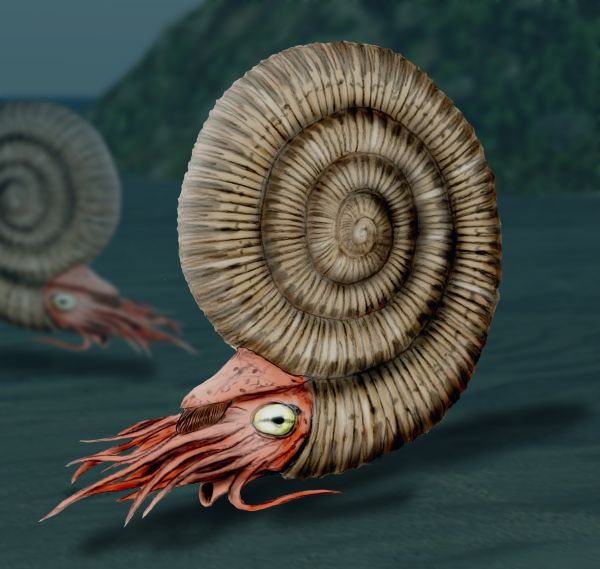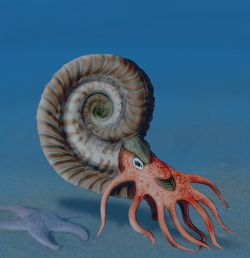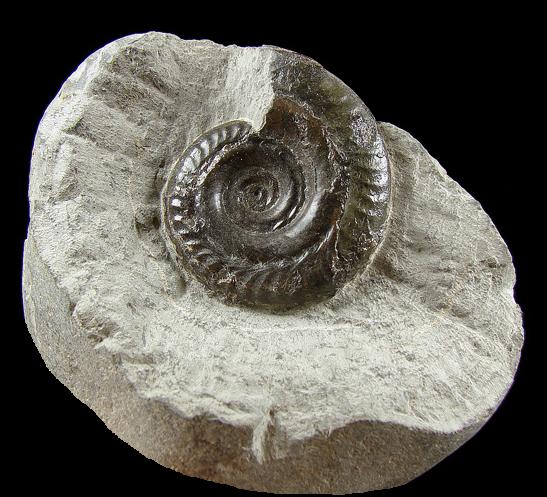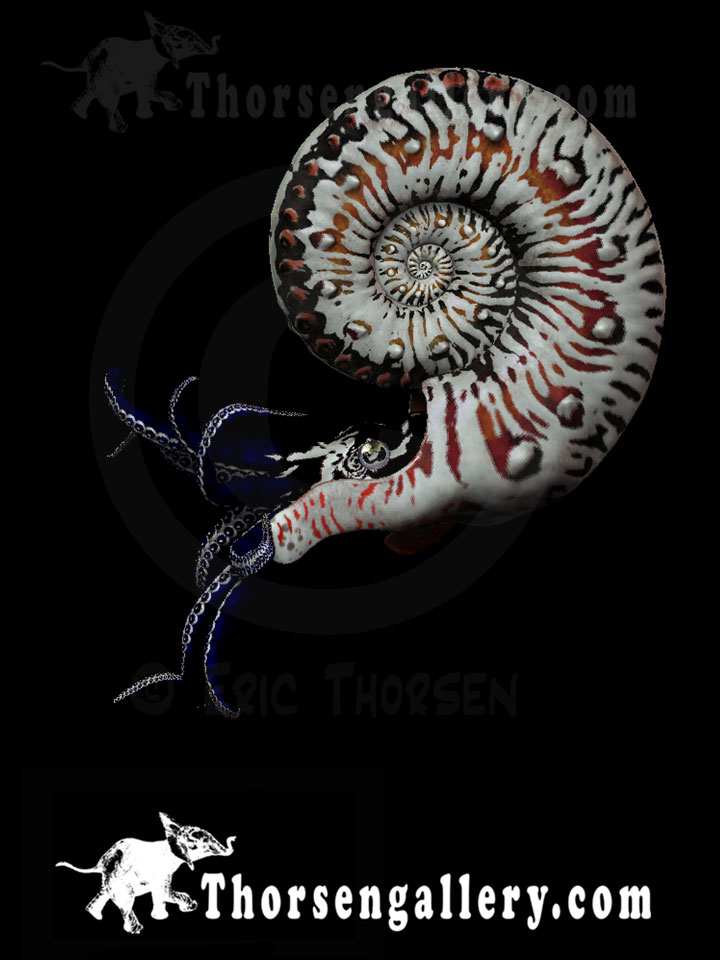[Recent Entries][Archive][Friends][User Info]
March 31st, 2012
| March 31st, 2012 | |
|---|---|
| 04:53 pm [industrialterro] [Link] |
Arietites Arietites is a genus of massive, giant evolute, psiloceratacean ammonites in the family Arietitidae in which whorls are subquadrate and transversely ribbed and low keels in tripicate, separated by a pair of longitudinal grooves, run along the venter. Fossils are known world wide from the lower Sinemurian stage of the Lower Jurassic. Similar genera include Megarietites in which the keels are reduced and Epammonites in which the ribs are more closely spaced.
Tags: Аммониты, Вымершие беспозвоночные, Юра |
| Time | Event |
| 05:18 pm [industrialterro] [Link] |
Aspidoceras Aspidoceras is an extinct ammonoid cephalopod genus that lived during the Late Jurassic (Kimmeridgian) with a fairly broad distribution. Aspidoceras, named by Zittel, 1868, is the type genus for the persphictacian family Aspidoceratidae and subfamily Aspidoceratinae in which it is included. Aspidoceras has an evolute shell with quadrate-rounded or depressed whorls that have two rows of tubercles, the outer near the middle of the whorl sides. The outer row soon fades in many species. Some species are also ribbed. The venter, or outer rim, is generally wide and broadly arched. Aspidoceras is predated by Euaspidoceras, possibly its ancestor, and is considered related to genera like Orthaspidoceras, Simaspidoceras, and Intranodites.
Ископаемые останки (1, 2, 3, 4):
Tags: Аммониты, Вымершие беспозвоночные, Юра |
| Time | Event |
| 05:32 pm [industrialterro] [Link] |
Asteroceras Asteroceras is an extinct genus of cephalopod belonging to the Ammonite subclass. Asteroceras fossils may be found at Lyme Regis in the Asteroceras obtusum zone of Upper Sinemurian age. Asteroceras is a genus of Ammonites natvie to England durring the Jurassic Era. The genus of Asteroceras included five species, including Asteroceras confusum. Asteroceras fossils were most commonly found in the Lyme Regis, located in Dorset, England.
Tags: Аммониты, Вымершие беспозвоночные, Юра |
| Time | Event |
| 05:41 pm [industrialterro] [Link] |
Dactylioceras Dactylioceras was a widespread genus of ammonite from the Jurassic period, approximately 172 million years ago (mya). They are generally small, averaging 65 mm in diameter. Dactylioceras has a strong, ribbed shell. The ribs are slightly inclined forward, running over the outer edge, and either simple or forking at outer end. Though it eventually died out 180 mya, their style of ribbing was copied by numerous subsequent ammonite genera until the whole group became extinct 65 million years ago with the dinosaurs. Dactylioceras probably lived by scavenging on the sea floor. Mass mortality specimens of Dactylioceras are common, and perhaps suggest that these ammonites may often have died shortly after spawning. The dead shells were probably gently washed up into a shell bank on the margins of the Lower Jurassic seas. Flow tank experiments show that Dactylioceras was probably a slow swimmer. Dactylioceras has been collected from almost every continent, and was one of the most successful ammonite lineages ever. They are abundant throughout Europe, with exceptionally fine specimens found in England and Germany. Like many other ammonites, the genus Dactylioceras is extremely important in biostratigraphy, being a key index fossil for identifying their region of the Jurassic. The name Dactylioceras comes from the Greek dactyl, meaning “finger”, and refers to the shell’s branching ribs.
Tags: Аммониты, Вымершие беспозвоночные, Юра |
| Time | Event |
| 06:01 pm [industrialterro] [Link] |
Hildoceras Hildoceras is a genus of ammonite form the upper Lower Jurassic in the family Hildoceratidae. The shells are characterized by a narrow discoidal evolute shape, keeled venter, concave ribs along the outer flanks, and a shallow spiral goove running along smooth inner flanks. Whorls slightly overlap, cross sections are compressed. The ventral keel is bordered on either side by a shallow groove. The genus was named by Alpheus Hyatt after Saint Hilda in 1876, and fossils have been found in Europe and Japan. Род Hildoceras, объединяющий одних из наиболее типичных аммонитов юрского периода, был назван в честь святой Хильды. Самый распространенный вид рода Hildoceras bifrons является руководящим ископаемым: он существовал на протяжении короткого, по геологическим меркам, периода времени и потому дает возможность довольно точно датировать слои горных пород. Его широкая географическая распространенность позволяет проводить детальное сравнение содержащих его слоев и точно указывает на их одинаковый возраст. Эти аммониты отличаются эволютной плоскоспиральной раковиной: каждый новый оборот располагается поверх предыдущего. Сечение оборотов имеет характерную квадратную форму. Интересной особенностью Hildoceras являются простые, серпообразно изгибающиеся, ребра, развитые на боковых сторонах раковины. На боковой поверхности проходит продольная ложбинка, по обе стороны от которой ребра имеют различную ориентацию. Род аммонитов Hildoceras получил наиболее широкое географическое распространение в юрском периоде. Множество окаменелостей этого рода было найдено в Европе, Северной Африке, на Кавказе, в Турции, Иране и Японии. Аммониты, вместе с современными кальмарами и осьминогами, относятся к цефалоподам, или головоногим моллюскам. Основным отличием аммонитов служит их внешний скелет в форме спиральной раковины, тогда как кальмары ограничиваются минимальным внутренним скелетом, а у осьминогов его и вовсе нет. Кальмары и осьминоги также живут в морях и океанах, они весьма умны и охотятся на других водных животных. Вполне вероятно, что их поведение во многом сходно с поведением аммонитов.
Tags: Аммониты, Вымершие беспозвоночные, Юра |
| Time | Event |
| 06:18 pm [industrialterro] [Link] |
Kosmoceras Kosmoceras — род вымерших головоногих моллюсков семейства Kosmoceratidae, подкласса аммоноидеи. Были распространены, главным образом, в Суббореальной области Панбореальной биогеографической надобласти в среднем-позднем келловее (средняя юра). На аммонитах рода Kosmoceras основано зональное расчленение среднего и верхнего подъярусов келловейского яруса. В большинстве разрезов Европы представители рода Kosmoceras исчезают незадолго до конца келловея. Самые поздние Kosmoceras известны из биогоризонта paucicostatum (зона lamberti верхнего келловея) Северного Кавказа. Раковины рода Kosmoceras были покрыты шипами, отличающимися у различных видов по форме — от небольших округлых выступов до тонких иглообразных. Однако данные шипы плохо и очень редко сохраняются в ископаемом состоянии.
Tags: Аммониты, Вымершие беспозвоночные, Юра |
| Time | Event |
| 06:36 pm [industrialterro] [Link] |
Peltoceras Peltoceras is an extinct ammonite genus from the aspidoceratid subfamily Peltoceratinae that lived during the later part of the Middle Jurassic (U Callovian). The shell of Peltoceras is evolute with whorls hardly embracing, so that all whorls are mostly exposed. The outer rim, which is known as the venter, aligning with the lower part or belly of the animal, is nearly flat. Inner whorls have strong ribs that bifurcate and trifurcate on the ventral margin. The outer whorls have large simple ribs and two rows of massive lateral tubercles, the outer row developing first.
Ископаемые останки (1, 2, 3, 4):
Tags: Аммониты, Вымершие беспозвоночные, Юра |
| Previous Day | 2012/03/31 [Archive] |
Next Day |

































